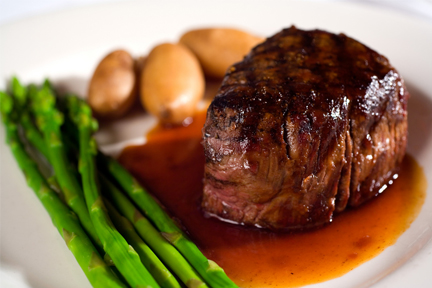
Agricultural News
Beef Tenderness Continues to Improve, New Survey Results Show
Fri, 06 Apr 2012 13:51:39 CDT

Tenderness is a critical component of beef's palatability or taste and it helps drive consumer enjoyment and demand for beef. With funding from The Beef Checkoff, the industry has been tracking beef tenderness for 20 years through the National Beef Tenderness Survey. The original 1990 Survey revealed tenderness problems with cuts from the top sirloin, round and chuck, and identified a need for longer and more consistent beef aging. The 1999 Survey revealed a 20% increase in tenderness as compared to 1990 with improvements attributed to fewer no-roll steaks (steaks without a grade designation) sampled, an increased availability of steaks grading Choice and Prime, and adoption of more gradual chilling procedures and longer aging periods. Despite noticeable improvements, tenderness issues still existed in 1999. Results of the 2005/2006 Survey showed an 18% overall increase in tenderness as compared to 1999. This increase resulted in overall beef tenderness levels that were at an all-time high.
In 2010/2011, The Beef Checkoff commissioned the fourth National Beef Tenderness Survey to quantify the status of tenderness as compared to previous Surveys. Researchers at Texas A&M University led the effort with collaborative support from Texas Tech University, California Polytechnic State University, the University of Florida, the University of Missouri, North Dakota State University, Oklahoma State University and Penn State University. Twelve U.S. cities were selected for sampling and each city was sampled once between March 2010 and February 2011. In each city, two to three retail chains, representing at least one-third of the total-area-market share, were sampled for product in four stores per chain. Therefore, a total of eight to 12 supermarket stores per metropolitan area were sampled. In addition, if a membership-based retail store existed in a city and was not included in the one-third market share, one store of the membership-based chain representing the largest market share was sampled.
From the retail stores surveyed, researchers selected Top Blade Steak; Ribeye Steak, lip on, boneless; Ribeye Steak, lip on, bone-in; Top Loin Steak, boneless; Top Loin Steak, bone-in; T-Bone Steak; Porterhouse Steak; Top Sirloin Steak, boneless, cap off; Top Round Steak; and Bottom Round Steak. In a random assignment, steaks were shipped to one of the collaborating universities to be evaluated by a consumer panel or tested by Warner-Bratzler shear force.
Researchers also sampled one foodservice distribution facility in each of five cities. Foodservice cuts for each available quality grade were sampled including the Ribeye Roll Steak; Top Loin Steak, boneless; and Top Sirloin Butt Steak, center cut, boneless. Foodservice cuts were shipped to the University of Missouri for random assignment to either consumer sensory panel or Warner-Bratzler shear force evaluation. New as compared to the 2005/2006 Survey, steaks from the round were assigned to one of two cooking methods moist-heat cookery in a convection oven or dry-heat cookery on a grated, non-stick electric grill. Foodservice steaks were cooked on a gas grill and all cooking methods were identical across research sites.
Significant 2010/2011 Survey findings:
Approximately 64% of retail cuts were labeled with a store brand.
Retail beef was aged an average of 20.5 days compared to 22.6 days in 2005/2006. The aging period for retail cuts ranged from 1 to 358 days as opposed to a range of 3 to 83 days in 2005/2006.
The mean percentage of retail subprimals aged (measure of post-fabrication times) less than 14 days (considered minimum recommended aging time) was 35.7%.
For foodservice cuts, the average aging time remained relatively constant at 28.1 days compared to 30.1 in 2005/2006. The aging period for foodservice cuts ranged from 9 to 67 days.
Retail Top Blade Steaks had the lowest (most tender) Warner-Bratzler shear force values. Retail Bottom and Top Round Steaks had the highest (least tender) Warner-Bratzler shear force values.
All foodservice cuts had low Warner-Bratzler shear force values with the lowest being steaks from the Top Loin and Ribeye.
Comparing retail cuts, consumer sensory panelists rated the Top Blade Steak, the boneless Ribeye Steak, the boneless Top Loin Steak, and the bone-in Top Loin Steak the highest for overall like. Consumers rated the Top Blade Steak and the boneless Ribeye Steak the highest for tenderness.
In retail, the Top Sirloin Steak, Top Round Steak, and Bottom Round Steak were rated the lowest for overall like, tenderness like, and tenderness level.
Among foodservice cuts, the Top Loin Steak was rated highest by consumers across all attributes including overall like, tenderness like, tenderness level, flavor like, flavor level, juiciness like and juiciness level.
Most steaks evaluated in the 2010/2011 National Beef Tenderness Survey were considered tender or very tender. Moreover, the Warner-Bratzler shear force values in this Survey are similar to those of the 2005/2006 Survey, which were at an all-time high. However, aging was found to be less consistent in the current survey than it was five years ago, particularly at retail. Researchers speculate that increased featuring activity at retail may have resulted in short in-store supply of certain cuts at certain times of the year and consequently, short aging. Moreover the least tender cuts continue to be those from the round, suggesting the need for improved aging practices for round cuts and increased consumer education focused on proper preparation and cooking techniques to enhance the eating experience of leaner, less tender round cuts.
Benchmarking tenderness values every five years keeps us focused on continuous improvement.
Information from this and previous National Beef Tenderness Surveys will continue to be important information for the industry to use to gauge current tenderness performance and areas for potential improvement. In addition, this information is important in setting priorities for additional research that needs to be conducted to further improve beef quality.
A full executive summary of the 2010/2011 National Beef Tenderness Survey can be found by clicking here.
WebReadyTM Powered by WireReady® NSI
Top Agricultural News
More Headlines...



















